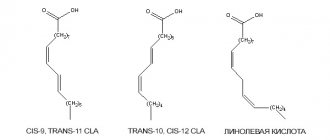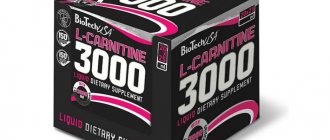Not all fats are the same. Some of them are important solely as a source of energy, while others have a wider range of beneficial properties. A substance called CLA is gaining more and more supporters among gym goers, bodybuilders and people wanting to lose weight. And for everyone who has not heard about this substance before, it’s time to find out what it is.
What is CLA?
Content:
- What is CLA?
- What does it contain?
- CLA and Linoleic Acid: What's the Difference?
- Linoleic and lipoic acid: what is the difference
- What is the benefit of fat?
- Role in the body
- Some benefits for the body
- What products contain
- Is CLA in food good for you?
- CLA as a supplement
- Is it true that CLA helps you lose weight?
- Benefits for athletes
- When and how to take
- What forms does it come in?
- Overdose and side effects
- Use in cosmetics
CLA, or conjugated linoleic acid (CLA), belongs to the 18-carbon family of omega fatty acids. More precisely, it is a group of isomers of linoleic acid with two double bonds separated by a methyl group.
In order to understand what CLA is, you first need to understand what the term “conjugated” means, since everything is more or less clear with the other two words in the name.
So, in the name CLA, this term indicates the presence of double bonds in the fatty acid molecule. And the conjugation (conjugation) of these double bonds can occur in different parts of the molecular chain. That is, conjugated fatty acids are those whose structural formula provides for the presence of double bonds between carbon atoms.
There are 28 forms of CLA, but the most important ones are c9t11 and t10c12. The formula of each CLA isomer indicates the presence of cis (c) and trans (t) double bonds. The numbers next to the letters indicate the location of these bonds on the fatty acid chain. The difference between the forms of CLA lies precisely in the variable placement of these double bonds. And this seemingly insignificant difference can radically change the properties of the acid and its role in the body.
But there are other isomers of CLA. For example:
- 9-trans, 11-trans;
- t11,c13;
- 8t10c;
- 9-hydroxy-trans 12-cis (source – Valerian Fori, teardrop seeds).
By the way, there is reason to believe that the latter isomer suppresses fat accumulation 8 times better than the basic isomer t10c12. And the 13-oxo-CLA isomer has twice the biological activity of c9t11.
Thus, CLA is a type of polyunsaturated fatty acid with cis and trans double bonds. In other words, CLA is technically a trans fat, but it is a naturally occurring trans fat and is found in many healthy foods. Scientists have conducted many studies and they all confirmed: while industrial trans fats are harmful to humans, natural CLA are not.
Effectiveness for weight loss
Manufacturers of drugs containing CLA claim that the substance takes part in the formation of body proportions because it breaks down fats in the abdominal cavity and abdominal area, and also promotes the growth of muscle mass. This advertising made linoleic acid quite popular among bodybuilding enthusiasts. However, is she really that good?
In 2007, more than 30 studies were conducted that showed that acid does indeed slightly reduce fat mass, but has almost no effect on muscle growth.
There are 12 known varieties of linoleic acid, but two have a significant effect on the body:
- Cis-9, Trans-11.
- Cis-10, Trans-12.
These fats have a beneficial effect on health and vitality. The presence of trans double bonds makes linoleic acid a type of trans fat. However, it does not harm the body. This is explained by its natural origin, as opposed to trans fats that are synthesized by humans.
What does it contain?
CLA is produced naturally in the digestive tract of ruminants and to a lesser extent in pigs and poultry. Under the influence of fermentation bacteria Butyrivibrio Fibrisolvens, linoleic acid is transformed into CLA. The most well-known isomers of CLA and the ones most commonly found in foods are 11-trans 9-cis. But the human body is not capable of producing CLA, so it uses dairy products and meat as a source of this beneficial substance. However, there is an exception to this rule: CLA is found in human milk. And this fact, according to scientists, is the best possible confirmation of how important this compound is for humans. After all, only substances important for human life are concentrated in human milk.
In addition, industrial production of CLA is also possible. But how is linoleic acid conjugated and why is it needed? This substance can be obtained through chemical treatment - as a result of partial hydrogenation of linoleic acid. More precisely, CLA is the result of an alkaline effect on vegetable oils, which contain large reserves of acid “raw materials”. The result is compounds with very high biological activity and a specific chemical composition.
CLA and Linoleic Acid: What's the Difference?
Linoleic acid is the most abundant omega-6 fatty acid. It is considered essential for humans, enters the body with food, and is then transformed into a substance known as arachidonic acid. Mainly found in vegetable oils, but also found in other foods.
And while CLA is technically a “version” of linoleic acid, it’s important not to confuse the two. At least when it comes to the effect on the body. Chemically, they are different compounds and have opposite properties. So, what is the difference between CLA and linoleic acid?
While linoleic acid (found in cottonseed oil and other plant foods) stimulates the formation of fatty tissue (a process known as lipogenesis), CLA, on the contrary, causes lipid oxidation, thereby inhibiting the accumulation of subcutaneous deposits. Another difference is the ability to influence the formation of tumors. If researchers consider linoleic acid as one of the substances that promotes the malignant degeneration of cells, then CLA has repeatedly confirmed its ability to inhibit the development of cancer. And finally, one more important difference. Linoleic acid sometimes helps increase blood cholesterol, and CLA, as you may have guessed, removes excess cholesterol and triglycerides from the body.
Scientists continue to study the properties of both substances, but already have many reasons to claim: an excess of linoleic acid against the background of a CLA deficiency can be dangerous to health.
Drugs
All dietary supplements for weight loss containing linoleic acid are approximately the same in composition. The cost depends on the manufacturer and the volume of packaging.
Weight loss drugs with linoleic acid
A short rating of such drugs will guide you:
- CLA. Now Foods (USA). $25.3.
- Reduxin light - with tocopherol and plant extracts. $23.6.
- Lipo-6 CLA is an exclusive matrix formula. Nutrex (USA). $21.9.
- CLA plus L-carnitine - with L-carnitine. VP Laboratory (UK). $16.9.
- Tropicana Slim is conjugated linoleic acid (made from sofloral oil). Evalar (Russia). $16.1.
- CLA Softgels. Optimum nutrition (USA). $16.
- Purecla. SAN (USA). $15.2.
- CLA 1000. Maxler (Germany). $15.
- Caffeine & CLA - with coffee. Myprotein (UK). $14.3.
- CLA with ginseng extract. Be First (Russia). $13.
Today, linoleic acid does not withstand competition in the sports nutrition market. More innovative formulas and more effective substances have appeared that allow you to see the first results within a week. All this has led to the fact that dietary supplements with CLA are becoming increasingly difficult to find: brands are curtailing their production and releasing more effective drugs.
On a note. Despite the fact that you have to wait a long time for the effect of losing weight from linoleic acid, it still has one undeniable advantage. As studies by Swedish scientists showed in 2001, it is difficult to find an alternative for burning visceral fat in the abdominal area.
Linoleic and lipoic acid: what is the difference
And one more note. When talking about the benefits of fatty acids, it is also important to distinguish between linoleic and lipoic acids. Although the names of both substances may seem similar to some, in fact they are different chemical components.
Lipoic acid is also known as vitamin N or thioctacid. It, like CLA, is found in red meat, but in addition, it is found in spinach, broccoli, potatoes, carrots, and yeast. Nutritionists strongly recommend not consuming it together with fatty acids (including linoleic acid); instead, it is better to combine it with another popular sports nutrition supplement - L-carnitine.
Linoleic acid, like gamma-linolenic acid (GLA) and arachidonic acid, is a member of the PUFA class (polyunsaturated fatty acids). A person needs this substance from birth, since the development and functioning of many organs depends on this acid. And if you analyze where this substance is found, then vegetable oils come to mind first. It is found in sunflower oil, corn oil, olive oil, safflower oil, flaxseed oil and many other products from this group. And it is this substance that serves as the source of conjugated linoleic acid.
What is the benefit of fat?
All types of lipids (from meat, eggs, dairy products, butter or vegetable oil, nuts, seeds) consist of fatty acids, the benefits and harms of which depend on various factors.
Polyunsaturated fatty acids (alpha-linolenic, linoleic, eicosapentaenoic, docosahexaenoic, conjugated linoleic) are important for athletes, monounsaturated (oleic, palmitic) are important for the cardiovascular system. But trans fats, like saturated palmic fatty acid or sterolic acid, usually have contraindications, so you should be careful with them.
Meanwhile, some of these substances are essential for humans, and their deficiency (especially during pregnancy) can have serious consequences. These include polyunsaturated omega-3 fatty acids (found in fish, seafood, eggs, some nuts and seeds) and omega-6 fats (mainly concentrated in vegetable oil, nuts, and seeds).
Both types of fatty acids play different roles in the body, but their balance is extremely important. Their correct proportions are necessary for the healthy functioning of the immune system, maintaining hormonal levels, and the functioning of the digestive and nervous systems. Ideally, the human body should receive more omega-3 and less omega-6. But in reality, everything happens the other way around.
The basis of omega-6 fats is called linoleic acid, which is found in cereals and vegetable oils (for example, corn, safflower, sunflower, canola). It is now known that excessive consumption of these omega-6 foods can have unwanted health effects.
Conjugated linoleic acid, in its effect on the body, is more reminiscent of omega-3 than omega-6, of which it is actually an isomer. In particular, CLA has anti-inflammatory properties, and is also able to “turn off” hunger, so to speak, by influencing the production of ghrelin (the hunger hormone).
Role in the body
Scientists discovered the biological activity of CLA in 1987. At that time, researcher Michael Parise discovered that when minced meat was exposed to high temperatures, substances were formed in the product that prevented muscle cell mutations. Experiments on mice have proven the effectiveness of these polyunsaturated acids in the fight against malignant tumors. Later, other researchers discovered that these substances can also reduce body fat percentage. And since obesity is one of the main problems of modern humanity, scientists became interested in the potential abilities of CLA to increase the effectiveness of weight loss programs.
Today it is already known that this substance:
- reduces body fat;
- increases insulin resistance (and therefore can prevent diabetes);
- has antithrombogenic and anticancer properties;
- prevents atherosclerosis;
- improves lipid profile;
- modulates the immune system;
- promotes bone mineralization;
- reduces blood glucose levels;
- improves digestion;
- helps fight food allergies.
However, the most studied property of CLA supplementation is its ability to reduce fat mass and increase muscle mass.
Biological role of conjugated linoleic acid (CLA)
The chemical properties of a substance, and, consequently, their role in human metabolism, depend on the spatial structure of the molecule and the arrangement of double bonds. Therefore, conjugated linoleic acid (CLA) plays a slightly different role in the human body than regular linoleic acid.
Michael Paris was the first to study CLA in the 1980s. He found that this substance was responsible for the anticancer effect of beef extract, discovered in 1979 in experiments on mice at the University of Wisconsin-Madison. CLA reduces the number of mutations in cell DNA. However, the full mechanism of CLA to counteract the development of cancer tumors has not yet been established.
After some time, it was also discovered that conjugated linoleic acid prevents atherosclerotic vascular damage and even stimulates the immune system. The turning point came from studies showing that CLA stimulates energy production mechanisms by breaking down fat cells and enhances tissue growth (primarily muscle).
Some benefits for the body
Regulates cholesterol and blood glucose levels
As it turns out, CLA is a good remedy for combating the increase in bad cholesterol, thereby preventing atherosclerosis, hypertension, heart and vascular disease.
Research has also confirmed the existence of a link between CLA consumption and the risk of diabetes. It turned out that CLA lowers blood sugar and increases the body's sensitivity to insulin.
Supports immunity
People on low-calorie diets are more susceptible to disease. And all because, without receiving enough nutrients, the body becomes more vulnerable, the immune system weakens. Introducing CLA into the diet will strengthen the immune system and also prevent the catabolic effects of the immune system during illness.
Prevents cancer
Conjugated linoleic acid has anti-cancer properties. This statement was made by experts after a series of experiments on animals. In addition, some claim that CLA may be beneficial in preventing breast, prostate, and digestive cancers. Penetrating into mutated cells, CLA molecules program them to die (apotosis).
Protects against allergies
After 12 weeks of using the dietary supplement CLA, the participants confirmed that their seasonal allergy symptoms decreased. Scientists have also noticed that CLA is beneficial for people with asthma. Against the background of this fatty acid, the patients' health status significantly improved and the sensitivity of the respiratory tract decreased.
Reduces joint pain
Research has shown that CLA is also beneficial for people with rheumatoid arthritis. The supplement in combination with vitamin E reduces joint pain, swelling and other symptoms of the disease. In this regard, scientists suggest that CLA could serve as a treatment for joint disease.
Linoleic acid and its isomer CLA
Both substances are classified as omega-6 fatty acids. The body cannot produce them on its own, so it is necessary to obtain these components from food or dietary supplements. Natural sources of the component are meat and dairy products. Vegans perfectly compensate for the lack of omega-6 with the help of vegetable oils.
Both the substance itself and its isomer are highly bioactive and help with various diseases. CLA reduces the risk of cancer and improves the functioning of internal organs, and also perfectly moisturizes the skin and hair.
Jarrow Formulas, Conjugated Linoleic Acid (CLA), 90 Softgels
★★★★★
RUB 1,047
More details
Other beneficial properties include:
- regulation of cholesterol levels;
- immune support;
- acceleration of muscle growth;
- reducing the risk of heart and vascular diseases;
- reducing the likelihood of an allergic reaction;
- stimulating the fat burning process.
But how can acid help you lose weight if it is fatty? It's simple: not all fats are bad. The substance improves lipid metabolism, so that excess calories are converted into energy rather than stored on the sides.
CLA (Conjugated Linoleic Acid) is an isomer of linoleic acid. They differ slightly in structure and beneficial properties. CLA acid is more effective for weight loss, so it is often used as an auxiliary drug during drying. Linoleic acid is best used for medical purposes to treat or prevent deficiency of the beneficial substance.
The benefits of CLA are described in more detail in the video:
CLA acid is an effective way to lose weight
What products contain
CLA in its natural form has been found in many foods, in particular from the meat and dairy group.
It is well known that the main sources of CLA are animal products. The highest content of this substance was found in kangaroo meat, slightly less in the meat and milk of ruminants (cows, goats, sheep). Meanwhile, the concentration of CLA in these products largely depends on what the animals ate. For example, CLA content is sometimes 3 to 5 times higher in beef and dairy products from grass-fed animals than from those whose diets were dominated by grains and animal feed. Table of CLA content in food
| The product's name | CLA content (mg) per 100 g fat |
| Beef (pasture raised) | 2100 |
| Swiss cheese | 660 |
| Mutton | 560 |
| Cow's milk | 550 |
| Butter | 470 |
| Yogurt | 470 |
| Sour cream | 460 |
| Cottage cheese | 450 |
| Beef | 420 |
| Cheddar cheese | 360 |
| Turkey | 250 |
| Sunflower oil | 100 |
| Linseed oil | 100 |
| Chicken | 90 |
| Pork | 60 |
| Chicken yolk | 60 |
| Salmon fillets | 30 |
But the data indicated in the table is approximate, and these data may differ in meat from different manufacturers. The fact is that the concentration of CLA in meat and milk directly depends on the animal’s diet. The more frequently livestock consumed fresh grass, the higher the CLA. For this reason, meat from confinement-raised cows may not be a good source of conjugated linoleic acid.
Moreover, American scientists have calculated: modern veal (and these data are indicated in the table) contains only a third of the CLA values that were in the meat of the 1960s.
Contraindications and precautions
Despite the apparent safety of the component, sometimes you should not take medications with it. Contraindications include:
- pregnancy and breastfeeding;
- age under 18 years;
- individual intolerance.
In such cases, it is better to choose natural sources rather than drugs containing CLA. The diet must include vegetable oils, meat and dairy products. The amount of conjugated linoleic acid they contain will not be enough for weight loss, but it is quite enough to compensate for the lack of PUFAs.
Is CLA in food good for you?
The natural version of CLA, as already mentioned, is found in meat and dairy products. Researchers studying the properties of CLA have never overlooked the natural version of the fatty acid. And after long-term observations, we made several conclusions.
First, people who eat plenty of foods containing CLA are less likely to develop some chronic diseases, including type 2 diabetes and cancer.
Secondly, research has shown that in regions where cows eat grass as their main diet, people get more CLA and are less likely to suffer from heart disease. Although not everyone in the scientific world agrees with this assumption. Some do not attribute these results to the CLA.
As for CLA's most well-known fat-burning ability, it turns out that the c9t11-type isomer (found in foods) is less beneficial for this purpose than the "chemical" version of CLA.
CLA as a supplement
To experience all the benefits of this acid, food alone is not enough. In addition, foods containing CLA also tend to be high in saturated fat (aka bad fat). The researchers calculated that if someone tried to get at least 3 g of CLA from food alone, they would inevitably have to consume almost half a kilo of fat along with nutrients, which is more than 4,500 kilocalories.
And then dietary supplements come to the rescue. The CLA sports supplement is a way to get the fatty acid in its pure form, while eliminating the intake of excess calories. The active ingredient in supplements is most often obtained from safflower seeds or sunflower oil. As a result of chemical exposure to these products, the linoleic acid contained in them is converted into conjugated acid.
By the way, there is a certain difference between CLA contained in food products and those included in dietary supplements. While the c9t11 isomer is usually present in food, food additives are a substance whose structural formula is t10c12. This means that there is every reason to believe that both versions of CLA have different effects on the body.
Is it true that CLA helps you lose weight?
But still, CLA owes its extreme popularity to its ability to accelerate weight loss. Many may wonder: how can fat be beneficial in the fight against fat? Actually it can! Especially when it comes to essential fatty acids like CLA. Over the years of testing, scientists have conducted many studies using CLA. Some even suggest that it is one of the most researched weight loss substances in the world.
Scientists have determined that consuming CLA triggers a series of biochemical reactions in the body that speed up basal metabolism. Many studies indicate that CLA is more effective when it comes to obese individuals. But this substance can also effectively reduce body fat in healthy people.
Many studies have confirmed that CLA can cause significant fat loss. In addition, it has been confirmed that CLA not only gets rid of the lipid layer, but also improves the condition of muscle mass, in many cases increasing it. However, there are also results from other studies that either did not confirm the fat-burning effect of CLA, or the results when taking the supplement were insignificant.
An independent group of scientists examined data from 18 studies and reached their conclusions. So, the most pronounced effect of taking CLA is usually observed in the first 6 months of using the supplement. Then, over the next 2 years, efficiency slowly decreases, eventually reaching a so-called plateau period. The same researchers estimated that during the first six months of taking the supplement, the body can lose up to 100 grams of fat every week.
American scientists conducted an experiment in which participants were divided into two groups: healthy people and obese people. Participants in the experiment without excess weight took 4.2 g of CLA daily, and representatives of the second group drank 3.4 g of the supplement. After 12 weeks, both groups appeared to have lost quite a lot of fat. In addition, obese people are almost 4 percent more likely.
Another study was conducted with the participation of novice bodybuilders. They drank 7.2 g of CLA during training for 6 weeks. The result (compared to the control group that did not take the supplement) was a noticeable increase in muscle mass.
CLA was also tested in Sweden. There, 25 obese men aged 39 to 64 years participated in the experiment. They took 4.2 conjugated linoleic acid daily for 4 weeks. After the time allotted for the experiment, it turned out that on average each of them had lost one and a half centimeters in waist circumference.
Previously, researchers assumed that the ideal fat-burning complex is a mixture of equal parts of isomers t10c12 and c9t11. But in the process of research, they discovered that it is the t10c12 isomer that is responsible for preventing obesity.
Interestingly, CLA has confirmed its effectiveness in the treatment of so-called male obesity (“apple” type, when fat accumulates in the abdominal area). Researchers consider this an important discovery, since this type of obesity is more difficult to treat and is considered one of the factors that increases the risk of developing diseases such as diabetes, atherosclerosis, autoimmune diseases, hypertension, and dysbiosis. And it is this type of obesity that causes an increase in cholesterol and triglycerides in the blood.
By the way, only after carefully studying the properties of CLA and L-carnisone, many agreed that the Atkins diet (developed by nutritionist Robert Atkins) is indeed effective. Meat, butter and dairy products are not dangerous for your figure, unless you fry them and combine them with foods with a high glycemic index.
Benefits for athletes
Many people know that CLA effectively reduces body fat. Meanwhile, at one time, researchers noticed that often against the background of a decrease in the fat layer, the total weight does not decrease, and sometimes even increases. And scientists have found an explanation. It turns out that in addition to burning fat, CLA plays another role - it improves muscle growth.
CLA is more often thought of as a fat-burning product, but research has also confirmed that CLA is important for individuals looking to build muscle mass. It is believed that conjugated linoleic acid (alone or in combination with supplements such as creatine and whey protein) promotes muscle growth and strengthening. For this reason, sports nutrition, along with many other products, also includes CLA. This substance is included in some protein shakes and, of course, it is included in the formulas of weight loss drugs. It is believed that the effect of taking the drug is better noticeable when drying.
The researchers conducted the experiment with the participation of 76 volunteers. Participants in the experiment received 5 g of CLA daily for 7 weeks and were engaged in a program consisting of strength exercises 3 times a week. After the time allotted for the experiment, it turned out that the athletes who consumed CLA had increased muscle mass by almost one and a half kilograms. While the results of the control group that did not use the supplement were only 200 g. Also, while taking CLA, athletes experienced a significant decrease in body fat (some lost up to 800 g of fat). In addition, the experiment participants who took the supplement showed better results during strength exercises.
Conjugated linoleic acid is useful for people who:
- strength training;
- fitness;
- swimming;
- running;
- race walking;
- dancing and other sports.
Mechanism of weight loss
Recently, experts are increasingly questioning whether linoleic acid is effective for weight loss.
Yes, studies have confirmed that it is an invariable participant in many processes in the body that ultimately lead to weight loss. For example:
- prevents the conversion of energy into fat deposits;
- accelerates many metabolic processes, including lipolysis;
- helps build muscle mass subject to constant physical activity;
- helps with “drying” the body;
- reduces the amount of insulin released;
- corrects the figure by burning fat;
- reduces volume in the waist (primarily) and hips, but only if you follow a low-calorie diet;
- prevents future weight gain;
- normalizes the level of triglycerides and cholesterol in the blood.
However, all this manifests itself in very small quantities. You often have to wait up to 2-3 months for visible results, and sometimes longer. In this regard, the same protein works much faster.
And yet, if the body lacks linoleic acid, if there are problems with the cardiovascular system and if sport is your second self, you can try to lose weight with the help of this unique dietary supplement. Moreover, there is no shortage of it in the modern sports nutrition market. And as a bonus, you will receive a strengthened immune system, a reduced risk of cancer, and an antioxidant effect.
Additional Information. The following symptoms indicate a deficiency of CLA in the body: fatigue, swelling (mainly on the legs and face), weakness, dry skin, dandruff, decreased immunity, menstrual cycle failure, peeling on the knees and elbows, peeling nails, memory impairment, decreased concentration, joint pain, bone fragility, infertility, problems with the cardiovascular system.
When and how to take
CLA is considered a safe substance for humans, so it can be included in the diet of men and women of different ages. Experts estimate that for effective fat burning you will need from 1.8 to 7 grams of CLA per day, and most studies have confirmed the safety of doses ranging from 3.2 to 6.4 grams of the substance per day.
Meanwhile, the optimal regimen for burning fat involves taking 0.6-2 g of CLA twice or three times a day (can be taken at any time of the day without reference to meals). The dose is adjusted individually, taking into account the stage of obesity or the amount of fat that needs to be eliminated. It is not recommended to take more - the effect of taking large doses will not affect the rate of weight loss or muscle building. But alcohol can affect the chemical properties of the drug (and therefore the expected result). For this reason, you cannot combine both substances. It is also important to know that CLA enhances the fat-burning properties of fucoxanthin. For this reason, both substances are considered highly compatible. But it is better not to combine CLA with fat blockers and resveratrol (they have opposite properties). And to completion. To actually feel the result, conjugated acid will have to be taken for 2-3 months, and also against the background of physical activity.
What forms does it come in?
Typically, CLA in the form of a sports supplement is in tablets and capsules, and is also found in mixtures for athletes. But conjugated fatty acids in capsules are considered optimal for the body.
Today, supplements containing CLA are a very affordable product that can be purchased both in sports nutrition stores and in pharmacies. In addition, the supplement is presented in different forms: in its pure form (for example, Solgar) or in combination with other beneficial substances. Most often, manufacturers add vitamins and minerals (in particular, group B substances, iodine, manganese), mineral salts, proteins, and other fat-burning substances.
Among the representatives of the second group is the fat burner “Tropicana Slim”, the capsules of which contain CLA and tocopherol concentrate. Another interesting option is CLA in the form of the Vitime Body Sculptor chocolate-caramel cocktail. In its composition, in addition to conjugated linoleic acid, the manufacturer introduced three types of proteins (whey, soy and casein micellar), vitamin C and manganese. The sports nutrition supplement Lipo Star System is also popular. The manufacturer declared that this drug contains CLA, L-carnitine and ginger extract (known for its ability to speed up metabolism and burn subcutaneous fat).
That is, the market offers both expensive drugs with a rich chemical composition and cheaper analogues consisting of pure CLA, the effect of which is usually identical. But still, the scheme and amount of supplements taken from different manufacturers may differ significantly. What exactly is included in the dietary supplement and how to take the drug will be explained in the instructions for use, which cannot be ignored (especially if you want to take the drug for several months).
And further. When choosing a sports nutrition supplement containing CLA, it is important not only to pay attention to the name of the product, but also to the manufacturer. Today on the market you can find at least a dozen products with the identical name - CLA. Among the most popular are those produced by such companies as Dymatize, Optimum Nutrition, Multipower, Trec Nutrition, Performance, Muscletech, Amway NUTRILITE, IronMaxx.
Reviews of Trec Nutrition CLA + Green Tea (180 capsules)
| Marsheva Elena rated the product 8 27.05.2020 14:26 | CLA for weight loss is suitable as a blocker of Grillin (hunger hormone), hunger becomes manageable, cla is not anorectic, does not burn fat based on my experience with use. Helps you stay on a strict diet, not eating in the evening or at night. Cla is the only one I like from this company, no unpleasant sensations or belching when used. Cla has a lot of beneficial properties on the body, which I clearly feel on the lungs (for those with chronic lung diseases, I recommend cla), whoever needs information about its action will find it freely available. I give it 8 and not 10 because each subsequent can is weaker in effect than the previous one, which is a question for the manufacturer. |
| Reply Is the review helpful? Yes 0 / No 0 | |
| ALEXANDER rated the product 10 31.08.2015 12:11 | In a previous review dated May 5, 2014 11:59, I wrote a negative review about this drug, giving it a low rating. Now I can confidently say that this is not due to this drug. The thing is useful and worthy. The invigorating component of green tea is especially pleasing. Overall rating is 9, to even out the previous rating I give it 10. |
| Reply Is the review helpful? Yes 3 / No 0 | |
| Novel rated the product 9 2.10.2014 18:00 | In general, CLA is a major thing; if it gives an effect in losing weight, it is no more than 0.5 - 1%, I think. The effect is distributed approximately like this: - 80% nutrition; — 15% sports; - 5% sports nutrition (mostly fat burner) So you can afford to invest an extra thousand and a half in drying - buy it! Specifically, these CLAs are better than others due to the presence of tea, and in a good dose (which can be a minus due to the additional vigor if you also drink fat). I dried myself with and without it - I didn’t feel much difference! If I buy it again, it will be more for my health (these oils also seem to be good for the heart). |
| Reply Is the review helpful? Yes 5 / No 4 | |
| Oksana 15 years of experience rated the product 10 4.09.2014 03:41 | excellent thing. I'm drinking Lipo-6 Black Ultra Concentrate - the second bottle and, to enhance the effect, I ordered CLA + Green Tea. I want to say that the effect is on the face, the fat is gone from the hips and sides. I eat 2 times less, I fill up quickly, I don’t feel like eating for a long time. There are practically no side effects, with the exception of mild allergies sometimes, but I myself have been allergic since childhood. I take Japanese vitamins and do not observe any negative consequences, as they write below. A decent drug. (I do pumping at least 5 times a week, without training I won’t know how this product will work) |
| Reply Is the review helpful? Yes 6 / No 1 | |
| ALEXANDER rated the product 4 5.05.2014 11:59 | I have been taking this drug for more than a month at the recommended dosage in combination with OMEGA-3 from Ultimate. I use it not for weight loss, but for general metabolism like OMEGA-6. In general, I began to feel worse, but not critical: I get tired faster, recover worse, my libido has dropped. I didn’t know what to blame, but I tied it to this, because I just started taking it then. Now I’ve reduced the dosage to one a day. Maybe it’s self-hypnosis, but I seem to have cheered up. I want to take a break and not drink at all, then I can say for sure. |
| Reply Is the review helpful? Yes 5 / No 8 | |
| Valex rated the product 10 20.03.2014 08:57 | GORGEOUS SUPPLEMENT |
| Reply Is the review helpful? Yes 6 / No 7 | |
| Anton rated the product 10 1.07.2013 14:55 | I’ve been cutting for the second month, the weight has stopped coming off, but the fat on my stomach has already remained. I bought this product + HMB Revolution (Trec Nutrition) and my weight began to decrease again. Plus there is vigor after taking it. I can’t say what product is responsible for reducing the weight. I am satisfied with the purchase. <Juris> 1.07.2015 16:31 Subcutaneous skin is difficult to remove, can be combined with Sculpt Absteel cream, item 12853. |
| Reply Is the review helpful? Yes 11 / No 4 | |
| Ruslan rated the product 10 19.12.2012 14:12 | This is the real thing guys! plus training and gym! |
| Reply Is the review helpful? Yes 7 / No 8 |
Overdose and side effects
There is a lot of evidence that CLA is beneficial for the body. However, it is important to remember that some nutrients that are beneficial in small quantities can be harmful if taken in large doses. Abuse of conjugated linoleic acid also poses certain dangers.
Research shows that large doses of CLA can lead to fat accumulation in the liver, which increases the risk of developing metabolic syndrome and diabetes. Animal and human studies have also shown that large servings of CLA may lower good cholesterol levels. In addition, an overdose of CLA also causes less serious side effects: diarrhea, abdominal pain, flatulence, nausea.
As for children and pregnant women, it is better not to take conjugated linoleic acid preparations for them. But that doesn't mean there shouldn't be natural sources of CLA in their diet. On the contrary, products containing CLA are beneficial for both children and expectant mothers.
Best materials of the month
- Coronaviruses: SARS-CoV-2 (COVID-19)
- Antibiotics for the prevention and treatment of COVID-19: how effective are they?
- The most common "office" diseases
- Does vodka kill coronavirus?
- How to stay alive on our roads?
CLA can be dangerous for people after surgery, with liver disease, and blood clotting disorders. Conjugated linoleic acid may slow blood clotting and thereby increase the risk of bruising and bleeding. But this again applies exclusively to CLA in the form of dietary supplements, and not to meat and dairy products. In addition, any instructions for use of the supplement contain a complete list of contraindications and side effects.
Composition and properties
Conjugated linoleic acid is a complex of geometric and positional isomers of linoleic acid. Positioned as a fundamentally important trans fat for health. The formula of the substance is almost identical to the Omega-6 formula.
Conjugated LA contains a lot of useful substances:
- vitamin A;
- vitamin E;
- vitamin D;
- vitamin K;
- wax;
- phytosterols (cholesterol neutralizers).
Since conjugated linoleic acid is not produced by the body itself, it must be obtained externally. The most healthy trans fats are found in dairy products and beef, but this is not enough for the body to function properly. You can make up for their deficiency with the help of dietary supplements. Supplements allow you to get CLA in its pure form without extra calories.
Conjugated linoleic acid is harmless for women and men. Additives based on it act in the following areas:
- strengthen the immune system;
- reduce the frequency of exacerbations of food allergies;
- enrich the body with additional energy;
- prevent the breakdown of proteins;
- give an antioxidant effect;
- reduce insulin resistance;
- perform cancer prevention;
- demonstrate anti-inflammatory activity;
- reduce weight.
Use in cosmetics
The antioxidant properties of CLA make it a useful component of cosmetics. Just like alpha lipoic acid, gamma linolenic acid and oleic acid, this fatty acid is used in facial and hair products. In particular, skin cream, which contains polyunsaturated fatty acids, has anti-aging properties, moisturizes, tones and tightens the skin, promotes its regeneration, and soothes inflammation. Conjugated linoleic acid is considered beneficial for any skin type, but it is most needed for dry skin, and is also indispensable for caring for the area around the eyes. In cosmetology and pharmaceuticals, this substance plays the role of one of the main anti-aging components and is used as a medicine against itching caused by various diseases. The use of masks containing fatty oils with CLA is useful for people with weakened hair that has lost its shine, as well as for the treatment of dandruff.
Conjugated linoleic acid is an important component in the diet of any person who cares about their health and appearance. Do you exercise intensively, but it is difficult to see the beautiful relief under a layer of fat that just doesn’t want to go away? Most likely, it's time to reconsider your diet. And of course... CLA to help you!
More fresh and relevant information about health on our Telegram channel. Subscribe: https://t.me/foodandhealthru
We will be grateful if you use the buttons:











